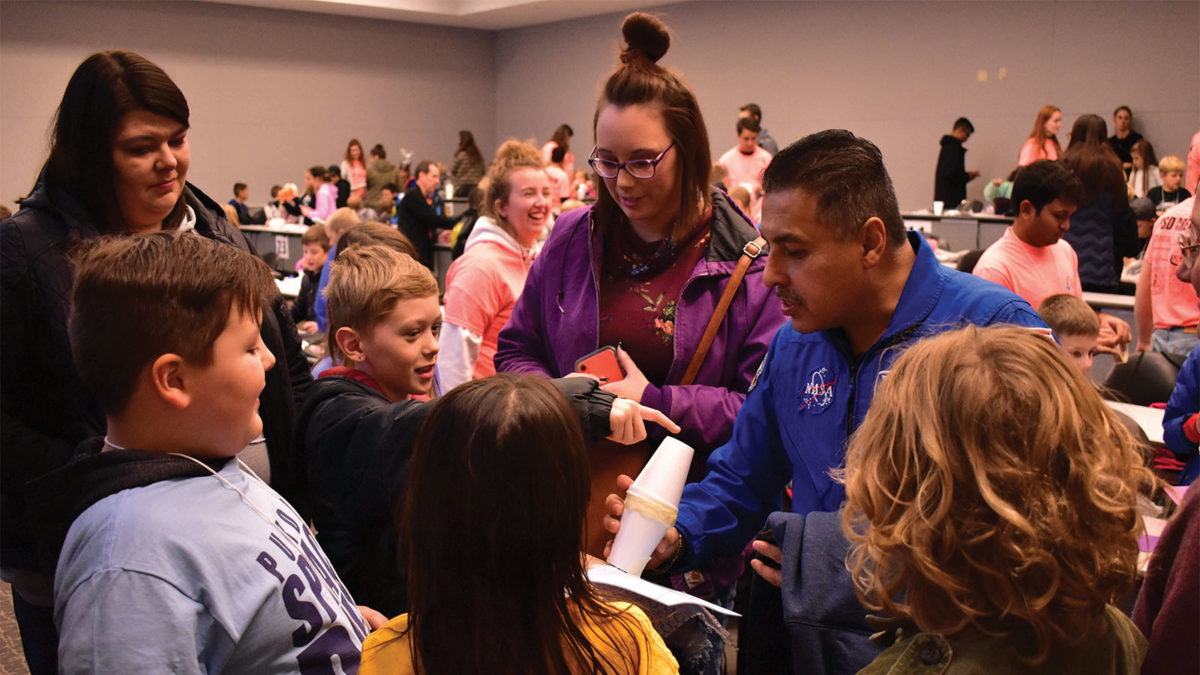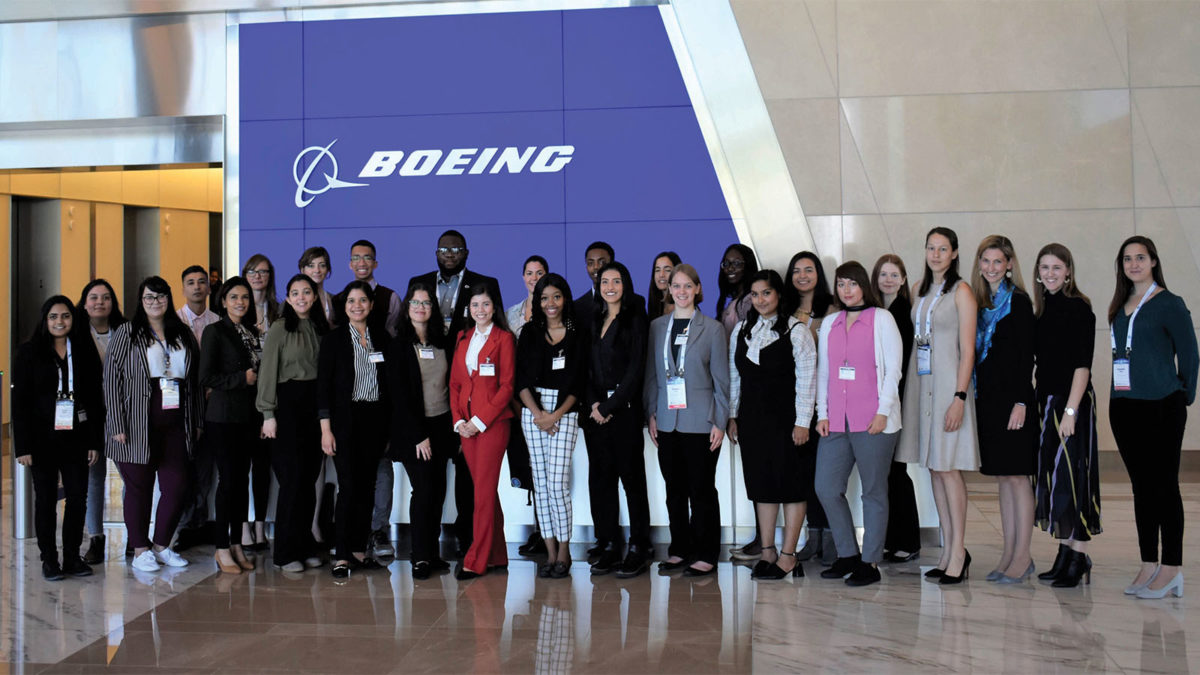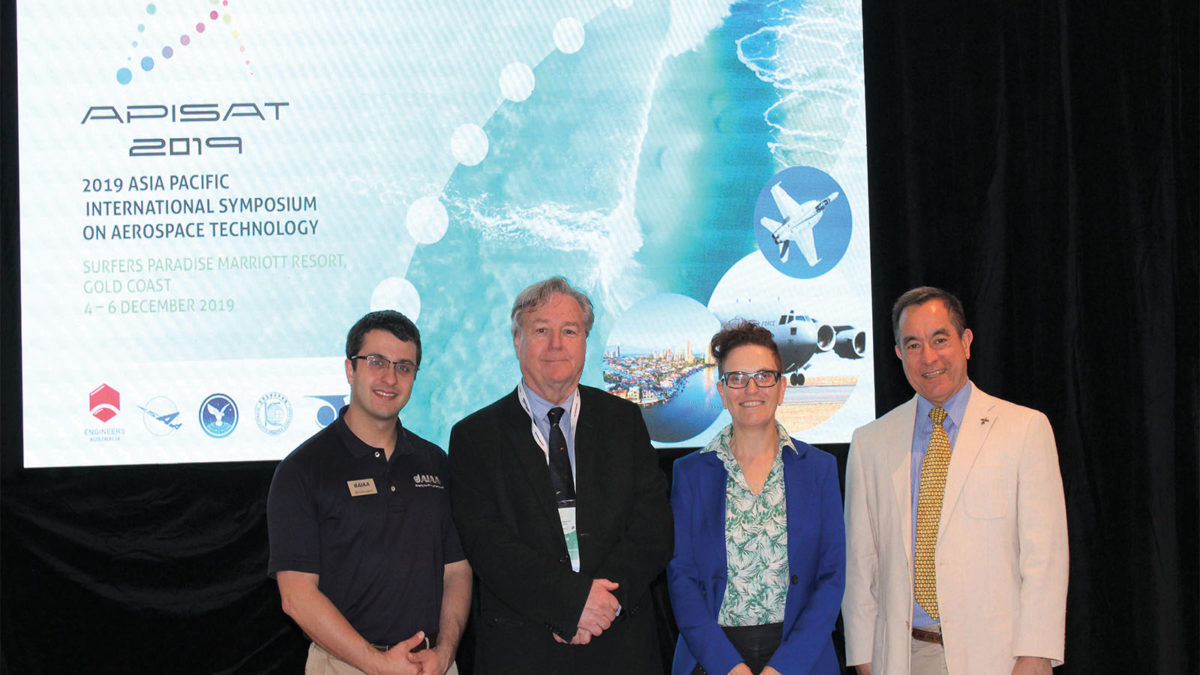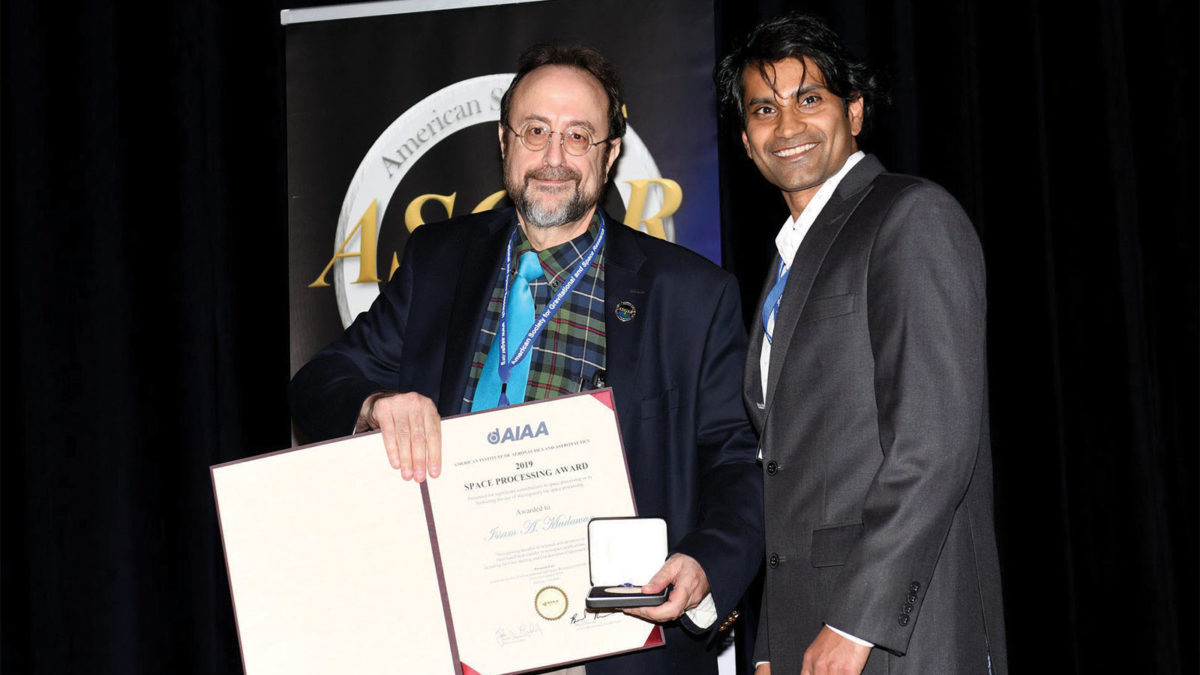- Making an Impact: Footsteps to the Future at Purdue
- AIAA Diversity Scholars Attend IAC
- AIAA Region VII-Australia Student Conference Took Place in December
- Aerospace Conference Spans Across the Asia-Pacific
- 2020 AIAA Sustained Service Award Winners Announced
- 2019 AIAA Space Processing Award Presented
- Call for Content Issued for AIAA’s New Space Conference ASCEND
- AIAA Associate Fellow Stull Died in August
- Former AIAA Member Spilker Died in September
- AIAA Associate Fellow Atwell Died in October
- AIAA Associate Fellow Etherington Died in October
Bulletin
AIAA Foundation Making an Impact: Footsteps to the Future at Purdue

By Geoffrey Andrews, Member, STEM K–12 Outreach Committee
Purdue University Space Day, held 8 November, celebrated its 24th year by setting new records for attendance and volunteer participation. This free one-day space camp has taken place at Purdue University every fall since 1996, teaching engineering and science principles to schoolchildren in grades 3–8 via fun, hands-on activities centered on space exploration. This year 855 children from around the Midwest attended the program, which was staffed by more than 400 students and volunteers. Each participant received an AIAA career booklet to keep them inspired to continue their studies in aerospace.
The theme of the day was “Footsteps to the Future,” a nod to both the 50th anniversary of the historic Apollo 11 moon landing and to NASA’s ambitious plans to return to the moon by 2024. The students were challenged to complete activities such as designing a paraglider wing for a model Gemini capsule, improvising an emergency air filter like the astronauts of Apollo 13, and building water rockets and balloon buggies.
This year, retired astronaut Jose Hernandez (STS-128) was Purdue Space Day’s guest of honor, talking to the students about his life’s journey to the astronaut corps and participating in various activities throughout the day. Plans are already underway for the 25th annual Purdue Space Day, which will be held in October 2020 – for more information, contact PSD@purdue.edu.
For more information about how you can get involved with AIAA’s educational activities, please contact Merrie Scott, at MerrieS@aiaa.org.
AIAA Foundation AIAA Diversity Scholars Attend IAC

Twenty-five AIAA Diversity Scholars attended the 70th International Astronautical Congress (IAC 2019) in Washington, DC, in October. Scholars attended plenary and technical sessions, Exhibit Hall programs, special sessions geared specifically for the scholars, as well as trip to the Boeing Long Bridge Facility.
The AIAA Diversity Scholarship aims to combat underrepresentation in the industry by providing students from underrepresented groups with the opportunity to attend AIAA forums and receive additional targeted programming that may help them succeed in the aerospace industry. This program is a collaboration of the AIAA Foundation and The Boeing Company.
Diversity scholarships will be offered for select AIAA forums throughout the year. The scholarship welcomes applications from students in all disciplines with an interest in aerospace, including but not limited to STEM fields, communications, law, industrial design, journalism, and political science. Please visit aiaa.org/Diversity-and-Inclusion for more information.
Student Conferences AIAA Region VII-Australia Student Conference Took Place in December

From 4 to 5 December, the AIAA Region VII Student Paper Conference, collocated with the 11th Asia-Pacific International Symposium on Aerospace Technology (APISAT), took place at the Gold Coast. Fourteen undergraduate AIAA student members, pursuing studies in Australia, India, Indonesia, Japan, and Italy, presented original research on a variety of topics. Their papers and presentations were evaluated by industry peers with many years of experience in the aerospace sector.
Judges collated their results and announced the winners. Reilly Palmer of the University of Queensland in Brisbane, Queensland (Australia) won first place with his paper “Hypersonic Vehicle for Space Access Using Hydrocarbon Fuel”; Lachlan Noller of the University of Southern Queensland in Toowoomba, Queensland (Australia) won second place with his paper “Restart of a 2D Hypersonic Inlet at Mach 6 using Slot Injection”; and Reece Otto of the University of Queensland in Brisbane, Queensland (Australia) won third place with his paper “Adjoint-based Grid Adaptation for CFD of High-speed Flows.” The first-place winner is invited to compete in the AIAA International Student Conference, which takes place at the AIAA SciTech Forum.
Section News Aerospace Conference Spans Across the Asia-Pacific

Australia hosted the 11th Asia-Pacific International Symposium for Aerospace Technologies (APISAT 2019), at the Gold Coast, 4–5 December 2019. The Royal Aeronautical Society Australian Division and Engineers Australia entered into a formal partnership to organize the event, which also included many AIAA members.
“This is the 3rd time that Australia has proudly hosted APISAT. It provides a wonderful opportunity for students, researchers, and professionals in aerospace to meet and share their ideas. The conference agenda and poster sessions push the boundaries of our understanding of the science and applications for aerospace technology,” said Cees Bil, conference chair.
Michael Spencer, a committee member from the AIAA Sydney Section, was a session chair for a series of presentations on spacecraft design. And the AIAA Region VII Student Conference was incorporated at the event alongside the APISAT agenda. Conference speakers and attendees came from universities and aerospace research institutes in various countries including Australia, China, Japan, Poland, South Korea, and the United States.
Bil commented, “It is good to see interests in aerospace science, industry and innovation are thriving. 2019 is a special anniversary year for celebrating aerospace: this is the 50th anniversary of the Apollo 11 lunar landing and the centenary anniversary of the first flight along the ‘kangaroo route’, hopping from London across Europe and South Asia to Australia. The symposium showed that the interests and applications for aerospace science and technology continue to inspire and drive new research activities and attract follow-on generations of aerospace researchers, scientists and engineers.”
Next year’s APISAT will be held in Jeju Island, Korea.
Award Announcements 2020 AIAA Sustained Service Award Winners Announced
AIAA is pleased to announce the winners of the 2020 Sustained Service Awards, which recognize sustained, significant service and contributions to AIAA by members of the Institute.
Nancy F. Andersen
Johns Hopkins University Applied Physics Laboratory
For sustained and diverse leadership contributions to AIAA through the Ground Testing Technical Committee, CASE, the Engineering and Technology Management Group, the Board of Directors, and the Council of Directors.
Brett A. Bednarcyk
NASA Glenn Research Center
For over 25 years of exceptional service to AIAA, the AIAA SciTech Forum, the SDM Conference, and the Structures Technical Committee.
Cassondra A. Dellinger
Dellinger Technologies
For sustained and dedicated service to AIAA’s Region II (South East) and its student members as Deputy Director of Education and Regional Student Conference Chair.
L. Michael Freeman
University of Alabama
For sustained and dedicated service to AIAA’s Region II (South East) and to the University of Alabama Student Branch members as faculty advisor.
Jeffrey W. Hamstra
Lockheed Martin Corporation
For outstanding and exemplary leadership of the Propulsion and Energy Group and long-standing support of technical activities within the Institute.
Christopher H. Jenkins
Montana State University
For over five decades of dedicated service to the Institute through distinguished leadership advancing the causes of the Gossamer and Spacecraft Structures Technical Committees.
Mohammad Javed Khan
Tuskegee University
For sustained and dedicated service to the AIAA technical programs and to the Tuskegee University Student Branch members as faculty advisor.
Joseph R. Marshall Jr.
BAE Systems
For over 25 years of continuous service to AIAA through Computer Systems Technical Committee leadership positions with a career focus on standardizing electronics for spaceborne systems.
Eric J. Pencil
NASA Glenn Research Center
In recognition of sustained contributions to AIAA at the section, region, and national levels.
Denise S. Ponchak
NASA Glenn Research Center
For outstanding leadership to AIAA technical activities, the development and management of highly successful conferences, and the funding of scholarships for future aerospace professionals.
Oleg Yakimenko
Naval Postgraduate School
In recognition of significant and sustained contributions to AIAA at the local, regional, and national levels.
For more information on this award, please visit aiaa.org/awards.
Award Announcements 2019 AIAA Space Processing Award Presented

Issam Mudawar, Purdue University, was the recipient of the 2019 AIAA Space Processing Award for “Recognizing decades of research and advances in fluid-based heat transfer in aerospace applications, including the Flow Boiling and Condensation Experiment in ISS.” The award, which honors significant contributions in space processing or in furthering the use of microgravity for space processing, was presented by Sunil Chintalapati, AIAA Microgravity and Space Processes Technical Committee Chair, at the American Society for Gravitational and Space Research (ASGSR) Meeting in November.
AIAA Announcements Call for Content Issued for AIAA’s New Space Conference ASCEND
AIAA has issued a Call for Content (ascend.events/experience/call-for-content) for ASCEND, a new outcomes-focused, transdisciplinary conference dedicated to the space economy.
ASCEND, happening 16–18 November 2020 in Las Vegas, Nevada, will focus on three macro themes:
Accelerating the near-term commercialization of space
Enabling the long-term human exploration and settlement of space
Exploring the security, policy, and legal ramifications of space endeavors
Scientists, engineers, economists, educators, legal professionals, artists, investors, and entrepreneurs are among the wide range of experts invited to submit content. ASCEND will explore emerging space-related applications and opportunities across all industries such as aerospace, agriculture, construction, entertainment, hospitality, manufacturing, mining, pharmaceuticals, and telecommunications.
Call for Content categories include, but are not limited to:
Defining the space economy
Education, outreach and workforce development
Information systems and software
National science priorities
National security space
Propulsion
Space exploration architectures and enabling infrastructures
Space life sciences and systems
Space policy and law
Space resource utilization
Space traffic management and integration
Transformative research and technologies
Subject-matter experts may submit to lead an engagement session, or present technical papers on their work in progress, completed research, and case studies. Submissions will be accepted at ascend.events/cfc through 17 March 2020.
Contact Nathan Boll, nathanb@aiaa.org, for more information about submissions. To register, visit ascend.events.
Obituary AIAA Associate Fellow Stull Died in August
Dr. Frank D. “Don” Stull, age 87, died on 9 August.
Dr. Stull graduated from Rensselaer Polytechnic Institute in 1953 (where he had been in the Air Force ROTC program), and received his commission as a 2nd Lieutenant in the U.S. Air Force.
He joined Westinghouse Electric as an engineer in the Management Training program before he was called to active duty and assigned to Wright-Patterson Air Force Base (WPAFB) as a test engineer providing in-house experimental support for the General Electric Aircraft nuclear propulsion program. Upon serving his two years of active duty at WPAFB he stayed on as a civilian project engineer in the Propulsion Laboratory, conducting analytic studies for the nuclear ramjet (PLUTO) and nuclear rocket (ROVER) programs. He was selected by the Propulsion Laboratory to attend the Oak Ridge School of Reactor Technology in 1958 and upon returning to the Propulsion Laboratory was promoted to Group Leader with the Electro-Jet Nuclear Branch, responsible for the development of electric thrust devices for the Air Force.
After two years with the Atomic Energy Commission in Cincinnati, OH, Dr. Stull returned to the Propulsion Laboratory in 1962 as Assistant Chief of the Ramjet Component Branch conducting analytic studies on scramjet propulsion for the original Aerospace Plane program, and went on to obtain his M.S. Degree in Mechanical Engineering in 1959 and his Ph.D. Degree in Mechanical Engineering in 1972, both from Ohio State University. During his career he served as Chief of the Ramjet Technology Branch, Research Specialist for the Ramjet Engine Division, and Technical Advisor to the Advanced Propulsion Division. He made significant contributions in the 6.1 and 6.2 ramjet/scramjet field including such projects as the dual-mode scramjet, dump combustors, swirl combustors, combustor pressure oscillations in ramjet engines and the successful ramjet powered missile, ASALM, and flight test program.
In 1985 Dr. Stull was detailed to work on the DARPA Copper Canyon program which eventually led to the National Aerospace Plane program (NASP). Additionally he led the computational fluid dynamics effort in analyzing hypersonic propulsion systems and was a member of the NASP High Speed IPT Team. Upon retiring in 1994 after 40 years, he joined the Universal Technology Corporation, working as a consultant in the area of hypersonic propulsion for an additional 12 years.
Over the years, Dr. Stull served on many high-level national and international panels and committees as a recognized ramjet/scramjet propulsion expert. In 1998 he was awarded the Bondarjuk Medal by the Russian Federation of Aerosport for Dr. Stull’s significant contribution to ram/scramjets research and international collaboration. Additional awards include Co-Winner of the First AFADL S.D. Heron Award in 1964, Co-Inventor of the “Dual Mode Supersonic Combustion Ramjet Engine” in 1972, Outstanding Professional Achievement Award by the Engineering & Sciences Foundation of Dayton in 1976, the NASA Group Achievement Award in 1991, and the AIAA Lifelong Member Service Award for 50 years of sustained contribution in 2011.
Obituary Former AIAA Member Spilker Died in September
James Spilker Jr., a central figure in the technical development of the Global Positioning System (GPS) and an adjunct professor of aeronautics and astronautics at Stanford, died on 24 September. He was 86.
Spilker studied at College of Marin before transferring into Stanford University’s undergraduate program in 1953. He earned his B.S., M.S., and Ph.D. degrees in electrical engineering at Stanford, where he became an expert in transistor electronics and communications theory.
Spilker’s first job out of college was with Lockheed Research Labs in Palo Alto, where he invented the delay-lock loop process, an optimal receiver for tracking satellites. Spilker then joined Ford Aerospace to help build a multi-satellite communications system for the military. From there, he and two Ford colleagues co-founded Stanford Telecommunications, Inc., building the company from three employees to 1,300 by 1999. Throughout the 1960s, Spilker would author or co-author key papers on signal timing technologies that would later make possible the precise tracking of satellites necessary for triangulating a user’s position on the ground.
In the early 1970s when Brad Parkinson approached Spilker about collaborating on the original GPS architecture. Spilker focused his efforts on improving both the accuracy and the economics of GPS to make the technology affordable.
Spilker and Parkinson co-authored Global Positioning System: Theory and Applications in 1996 (AIAA), the standard text for GPS. Spilker’s popular textbook Digital Communications by Satellite, first published in 1977, has seen 10 printings.
In 2001, Spilker joined Parkinson at Stanford as a consulting professor of aeronautics and astronautics. In 2005, he co-founded the Stanford University Center for Position, Navigation and Time, where he continued to work on satellite navigation.
Spilker was elected to the National Academy of Engineering, the Air Force GPS Hall of Fame and the Silicon Valley Engineering Hall of Fame, and was a Life Fellow of the IEEE and a Fellow of the Institute of Navigation. He also shared the Goddard Memorial Trophy with his collaborators on GPS. In 2015, he won the Thomas Edison Award from the IEEE. In 2019, Spilker was honored along with Parkinson and industry engineers Hugo Fruehauf and Richard Schwartz with the 2019 Queen Elizabeth Prize for Engineering (QEPrize) for their pioneering work in the development of GPS.
Obituary AIAA Associate Fellow Atwell Died in October
William (Bill) Atwell passed away at the age of 80 on 11 October.
Atwell received a B.S. in Physics/Math (English minor), and an M.S. in Physics/Math from Indiana State University, and was a Ph.D. candidate in Nuclear Engineering at the University of Florida.
Atwell was an internationally recognized expert in the field of radiation physics with 40+ years of experience in the areas of space radiation environments, high-energy particle transport through materials, active and passive dosimetry, spacecraft, satellite, and anatomical modeling/shielding analysis, radiation detection instrumentation, biological and physical effects, and related data analyses. He was one of the original members of the NASA Johnson Space Center (JSC) Space Radiation Analysis Group. His radiation research supported the NASA JSC Medical Sciences, Space & Life Sciences, and Engineering Directorate; NASA Jet Propulsion Laboratory; NASA Langley Research Center; and the European Space Agency (ESA)/German Space Agency.
Atwood authored over 250 technical and scientific publications, and was a science advisor/mentor for M.S./Ph.D. students at the University of Maryland, the University of Virginia, Colorado State University, USC, and Texas A&M University. He was the recipient of the Astronaut’s Silver Snoopy Award, Tech Fellowship, and numerous NASA, NATO, AIAA, and SAE/Aerospace awards and commendations. He was a chair of the AIAA Life Sciences and Systems Technical Committee and he received a 2004 Sustained Service Award for “his outstanding contributions and dedications to promote AIAA goals at the Houston Section and national level.”




